Derby's Heritage Part 11 - Old, New, Loved, Neglected
w/e 28 November 2010
All this week's pictures were taken
with a Kodak DX6490
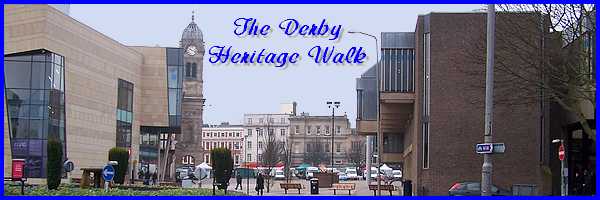
Alberto Semprini (1908 – 1990) found fame as
a pianist on the BBC where for many years he had a radio programme
of light music called "Semprini Serenade". He introduced
the programme by saying: "Old ones, new ones, loved ones,
neglected ones" and one or more of those words might easily
be applied to each of the sites or buildings we encounter in
this eleventh section of the Heritage Walk in Derby.
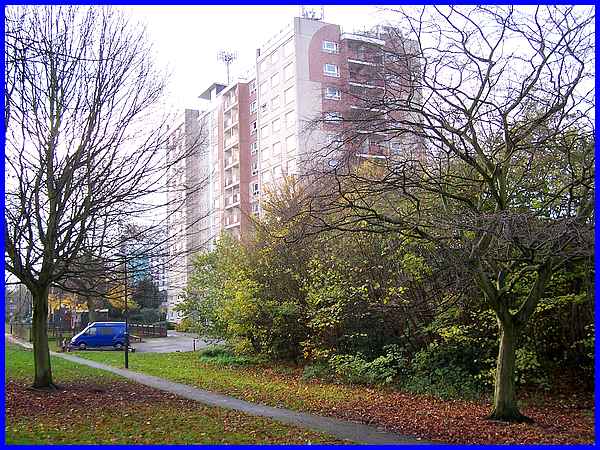
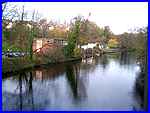  Leaving
the Little Chester area using Handyside's Bridge across the River
Derwent we can see to the north the boathouses (left) of the
Derby and Derwent Rowing Clubs that were established in 1879
and 1857. Our route though is along the path by the river (right)
to the south which soon leads to a comparatively "new"
building of Rivermead House (above). Leaving
the Little Chester area using Handyside's Bridge across the River
Derwent we can see to the north the boathouses (left) of the
Derby and Derwent Rowing Clubs that were established in 1879
and 1857. Our route though is along the path by the river (right)
to the south which soon leads to a comparatively "new"
building of Rivermead House (above).
Although there are many similar buildings to this throughout
the country, the eleven storey Rivermead House built in 1963
earns its place in the heritage of the city by having the distinction
of being Derby's first block of high rise council flats. Forty
eight solar panels were installed on the roof of the building
in 2009.
|
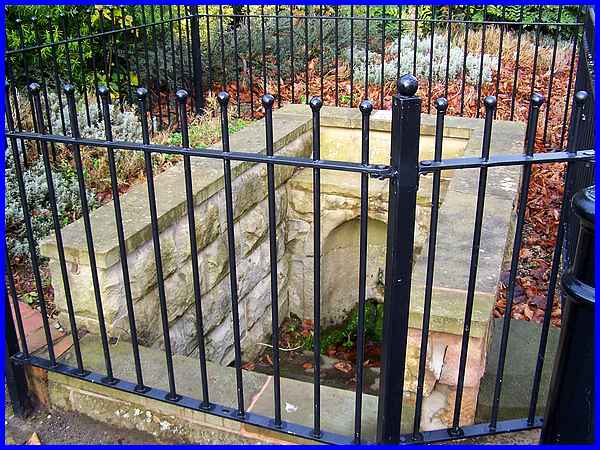
Turning right by Rivermead House and leaving the Derwent behind
leads to St Alkmund's Well - the last of Derby's Holy wells.
The son of a Northumbrian king, Alkmund was canonised for his
defence of Christianity against the Danes in the eighth century.
He was originally buried in Shropshire but secretly moved by
monks to Northworthy (i.e. Derby) in 1140 when invaders threatened
and a Saxon church was built near a spring to house his remains.
|
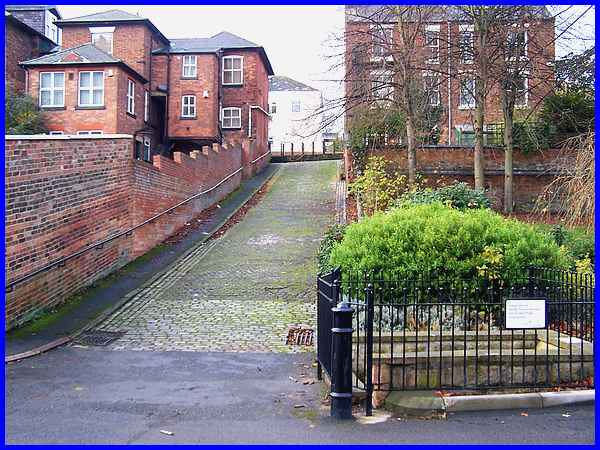
The well stands at the junction of Bath Street and Well Street
and as we head towards the site of St Alkmund's Church our route
is up the steep and cobbled Well Street to North Parade.
|
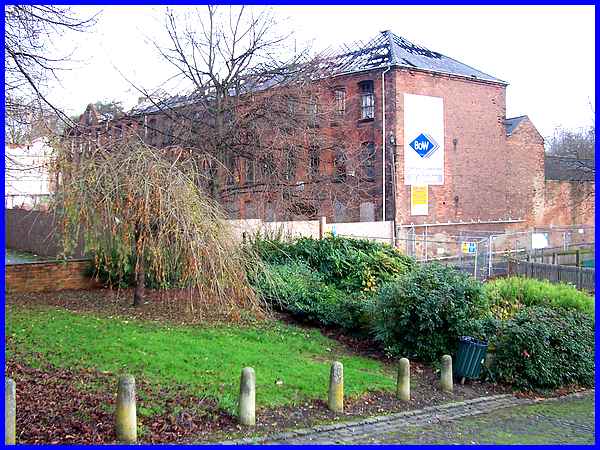
From Well Street we can see the frontage of the former Bath Street
Mills of 1848 but now the building is a sorry sight following
a devastating fire in 2009. The mills were built by George Holmes
to spin and weave silk and were converted twenty years later
for elastic web weaving. The company won numerous international
awards in the 1860s, 70s and 80s and before the end of the century
was employing between 200 and 300 people but they went out of
business in the 1920s. The mill was still used by other concerns
for a number of years, Spriggs' Cotton Mill closing in 1958.
Eventually put up for sale in 2008, the building was a potential
residential development before the 2009 fire curtailed that proposal.
(For more information and pictures see the Derelict Places
website and an article from 2008).
|
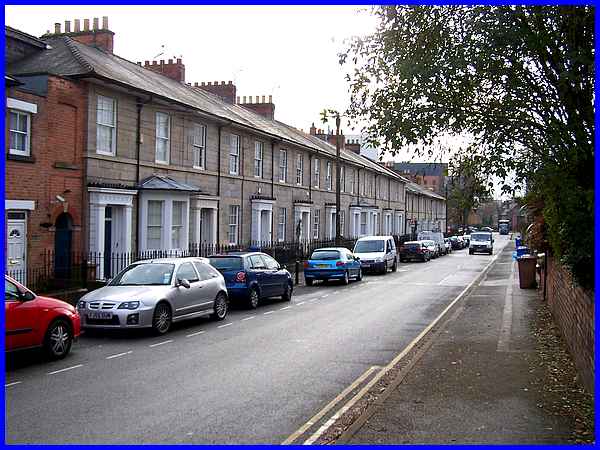
Numbers 1 to 16 North Parade are Grade II listed buildings. The
two terraces of eight houses in each were designed by William
Smith of Derby and built between 1818 and 1822. The land on which
they were built was made available by William Strutt (1756 –
1830), a civil engineer and a name well known in the cotton spinning
industry. The fall of the land towards the river allows for an
extra storey at the rear.
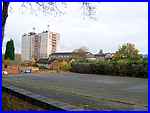 At the far end of the terraces
is an area of land (left) that is a former playground for a school.
Before that however the land had been a burial ground attached
to St At the far end of the terraces
is an area of land (left) that is a former playground for a school.
Before that however the land had been a burial ground attached
to St  Alkmund's Church,
the church itself stood a little further on between Derby Cathedral
on Queen Street and St Mary's Roman Catholic Church (right) on
Bridge Gate. St Alkmund's Church was built in 1846 on the site
of the earlier Saxon church dedicated to the city's patron saint
but succumbed to the demolition hammer in 1967 to make way for
the inner ring road that now bears the name St Alkmund's Way.
The lid of St. Alkmund's coffin now rests in Derby museum and
a modern church dedicated to the saint has been built on Kedleston
Road in the city. Alkmund's Church,
the church itself stood a little further on between Derby Cathedral
on Queen Street and St Mary's Roman Catholic Church (right) on
Bridge Gate. St Alkmund's Church was built in 1846 on the site
of the earlier Saxon church dedicated to the city's patron saint
but succumbed to the demolition hammer in 1967 to make way for
the inner ring road that now bears the name St Alkmund's Way.
The lid of St. Alkmund's coffin now rests in Derby museum and
a modern church dedicated to the saint has been built on Kedleston
Road in the city.
|
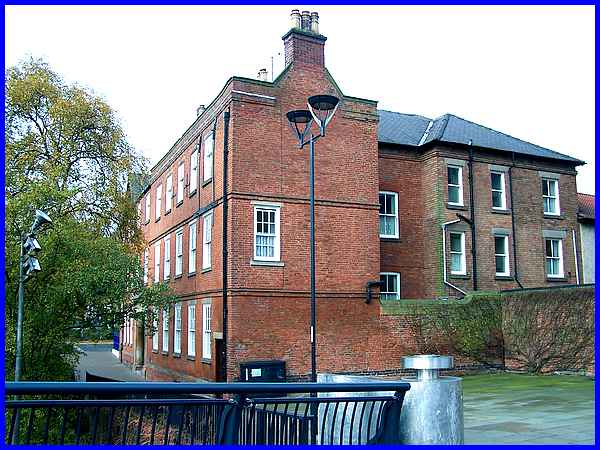
Turning into Bridge Gate means we have now completed the Little
Chester circuit and arrived back in front of St Mary's Church
and from the footbridge over St Alkmund's Way we can get a good
view of the Convent of Mercy that is housed in an early
eighteenth century building.
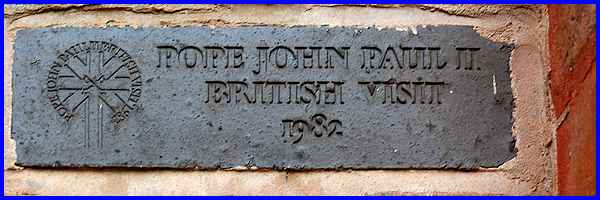
A brick in the wall of the convent commemorates the visit of
Pope John Paul II to Britain in 1982.
|
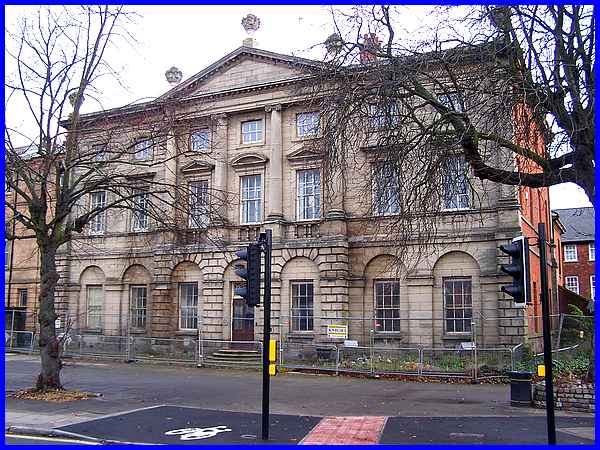
The first building we meet when moving from Bridge Gate into
King Street is St Helen's House.This falls into the "old"
category dating from 1766-67 but from the security fence around
it and the rusty state of the blue plaque by the door, it sadly
also appears to be in the "neglected" category too.
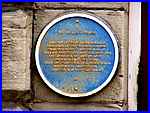 The
blue plaque states: "Joseph Pickford of Derby designed this
house in 1767 for John Gisborne. From 1803 - 1830 it was the
home of William Strutt F.R.S. and from 1830 -1861 that of his
son, 1st Lord Belper, previously M.P. for Derby. From 1863 -
1966 it housed Derby School whose Royal Charter was granted in
1554 by Queen Mary." A Derby Civic Society leaflet describes
St Helen's as "one of the most splendid of surviving provincial
gentry townhouses" and also affirms that it is "a vital
element on the edge of the World Heritage Site" so it is
sad to see it standing in its current state. The
blue plaque states: "Joseph Pickford of Derby designed this
house in 1767 for John Gisborne. From 1803 - 1830 it was the
home of William Strutt F.R.S. and from 1830 -1861 that of his
son, 1st Lord Belper, previously M.P. for Derby. From 1863 -
1966 it housed Derby School whose Royal Charter was granted in
1554 by Queen Mary." A Derby Civic Society leaflet describes
St Helen's as "one of the most splendid of surviving provincial
gentry townhouses" and also affirms that it is "a vital
element on the edge of the World Heritage Site" so it is
sad to see it standing in its current state.
|
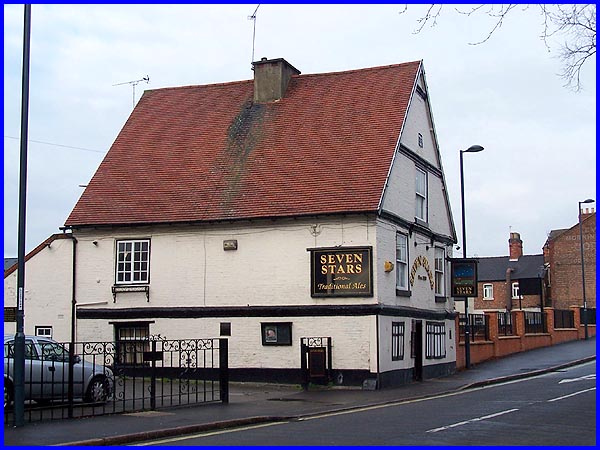
Across from St Helen's House is the Seven Stars Inn which is
a rare Derby timber framed building. The 1680 building has an
earlier core but was not recorded as an inn until 1775 when it
was known as "The Seven Stars otherwise The Plough".
It is now a Listed Grade II building and until 1965 beer was
still brewed on the premises. The neighbouring King Street China
Factory had supplied mugs to the inn for consumption of the brew
until the last one disappeared about 1945. There is some doubt
as to whether it was broken or purloined!
|

